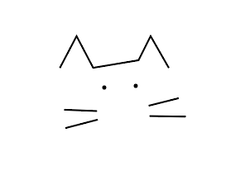THE MAGIC OF BLACK CATS
By Helen Wilson and Kate Wilson
Black cats have always been special to us. Our first cat was a wild stray living in a cave near our new apartment complex. We welcomed her to our doorstep, and she soon became a beloved household member. We named her “Spooky”, as she was
shy. Spooky soon gave birth to a small litter of kittens. One of her offspring later presented us with another black cat, named “Mischief”. Both were big favorites in our family, and now Pearl and Phil enrich our lives! We love to see their bright eyes light up when they awake from a nap, or reflect in the night.
Some people fear black cats, associating them with “black magic” and bad luck. One source of these superstitions dates back to the 13th century, when Pope Gregory IX decreed, in a document “Vox in Rama”, dated 6/13/1233, that all cats should be exterminated, particularly black cats, who were said to be “incarnations of Satan.” (in History, Eliz Yuko, 8/11/23).
Witches were the pagan practitioners during pre Christian times in Europe, and were later seen as being in competition with Christianity. They were killed, along with their cats. The widespread extermination of cats led to the spread of diseases caused by rodents, as well as crop destruction. (Lesson, don't mess with cats!)
During medieval times, people believed that the devil and witches could take the form of a black cat. The superstition developed that a black cat crossing ones path was bad luck, possibly on a mission from a witch, or the Devil in disguise! Italian legend cast them as an omen of death (classactcats.com).
In Greek mythology, the goddess of magic, Hecate, had a pet cat who was also a “familiar”, a supernatural being which assists a witch.
In Celtic mythology there exists a "cat-sìth". The cat-sìth is a creature said to resemble a large black cat with a white spot on its chest and haunts the Scottish Highlands. "It was believed that the cat-sìth could steal the souls that had yet to make the passage from the land of the living to the land of the dead, so they would hover around places where burials were about to occur, hoping to snatch the still wandering souls." But the Cat-Sith isn't all bad... "The day of Samhain is generally considered a special day within the cat-sìth lore. A saucer of milk would be left outside each household for the cat-sìth, as it was believed that, by leaving such an offering, the cat-sìth would take a liking to the household and its members and bless them for the coming year" (Folklore Scotland). Just make sure you remember to leave the milk out - you don't want to cross the Cat-Sith!
For some, black cats are a sign of good luck. People who work at sea have a special love for black cats. Fishermen’s wives believed that if they kept a black cat in their home, their husband was guaranteed to return from sea. British and Irish sailors believed that having a black cat on board ship brought good luck. (MA Maritime Academy). Probably the most famous black sea cat was “Oscar” who sailed on the German ship the Bismarck. When the ship sank in 1941, Oscar
was one of the only survivors, and his name was changed to “Unsinkable Sam.” He went on to survive the sinking of the torpedoed HMS Cossack and the HMS Ark.
Black cats enjoy a positive reputation in Japan, where they are believed to bring prosperity and wealth. "In the south of France, black cats are referred to as “matagots” or “magician cats”. According to local superstition, they bring good luck to owners who feed them well and treat them with the respect they deserve." (Life On La Lune). In ancient Egypt, black cats were revered and represented Bastet, the goddess of fertility and childbirth. In Norse mythology, "Freya is the queen of the Valkyries and the goddess of love and fertility. Two black cats pulled the chariot she rode." (Fabled Collective).
FACTS about Black Cats: There are 22 breeds of cat that have a solid black appearance, but the only true black cat is the Bombay, developed in the 1950’s, a cross between a Sable Burmese and a black American Shorthair. The NIH found that “genetic mutations” associated with black fur is linked to strong immune systems, and most black cats (75%) are male, due to their chromosomal make-up.
Black cats appear in pop culture, including 'Salem' (Sabrina the Teenage Witch's witty sidekick), 'Binx' in Hocus Pocus, 'Felix the Cat' (Star of silent cartoon shorts in the 1920s), 'Bagheera' (the black panther from The Jungle Book), and 'Luna' from Sailor Moon. All wonderful ambassadors for our beloved black cats.
Sadly, a bias against black cats persists and they are less likely to be adopted. But organizations like Boston-area Black Cat Rescue are making it their mission match black cats with their forever homes that they deserve. Some photographers even lend their skill to capturing the beauty and character of black cats, so that they can put their best paw forward in the adoption process. Consider welcoming a wonderful black cat into your home, and enjoy the magic!
Can other black cat owners relate? Have you ever talked to a pile of laundry, thinking it's your cat?




